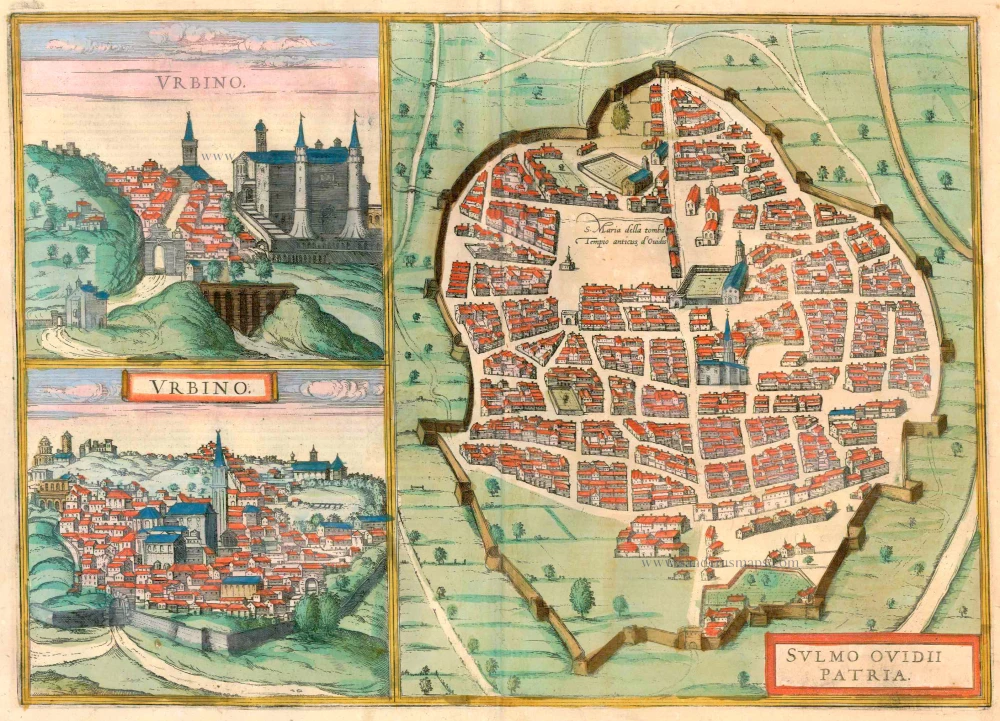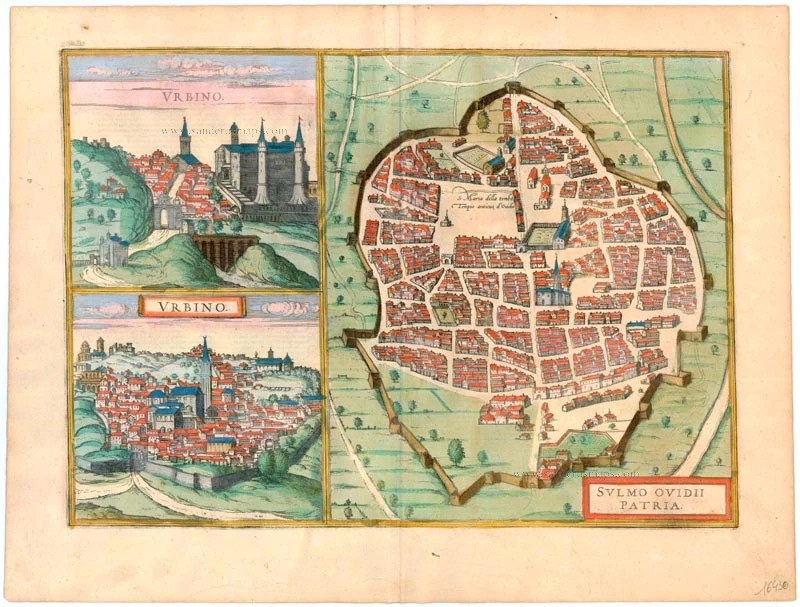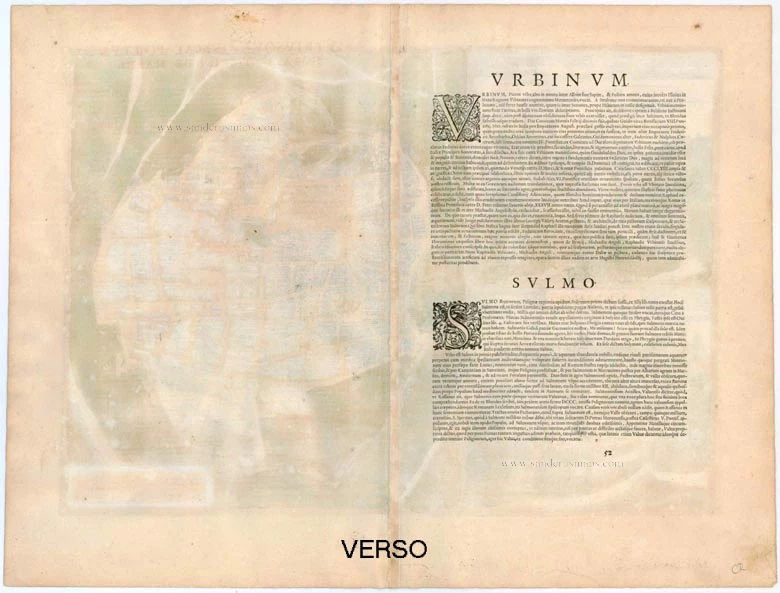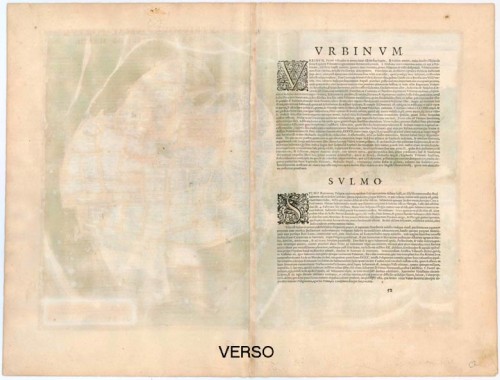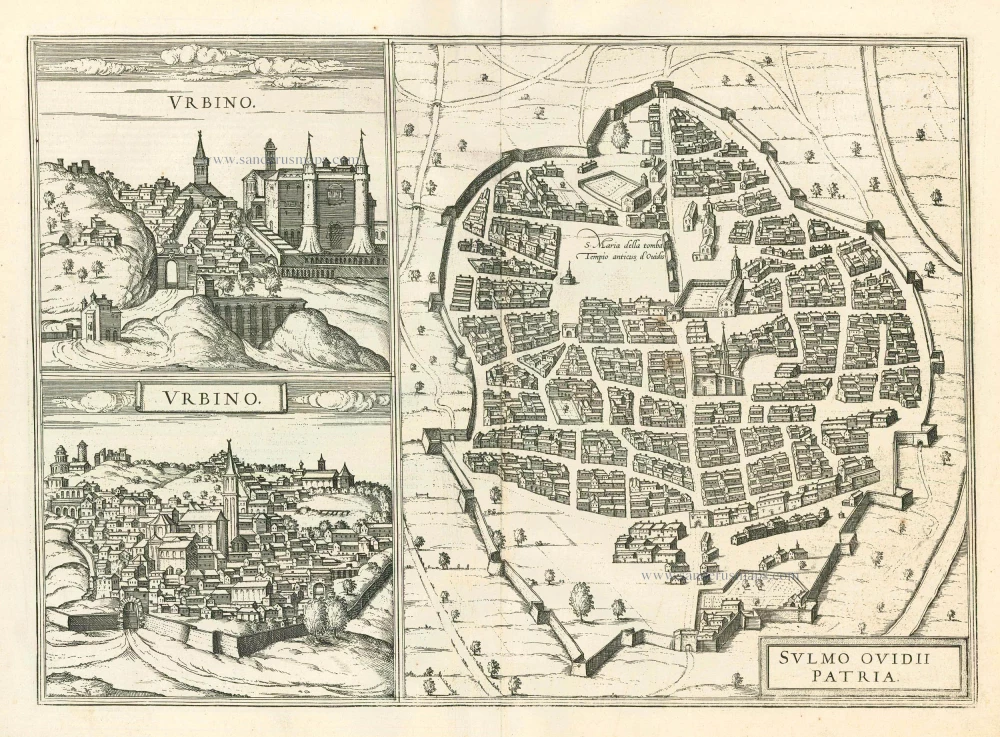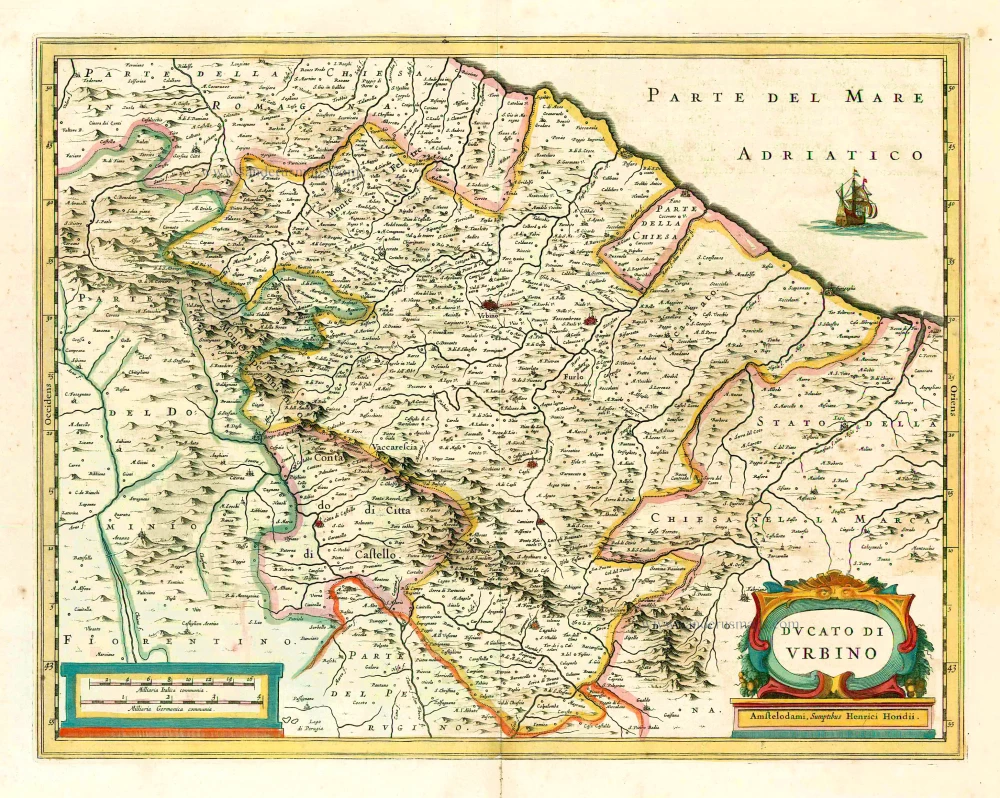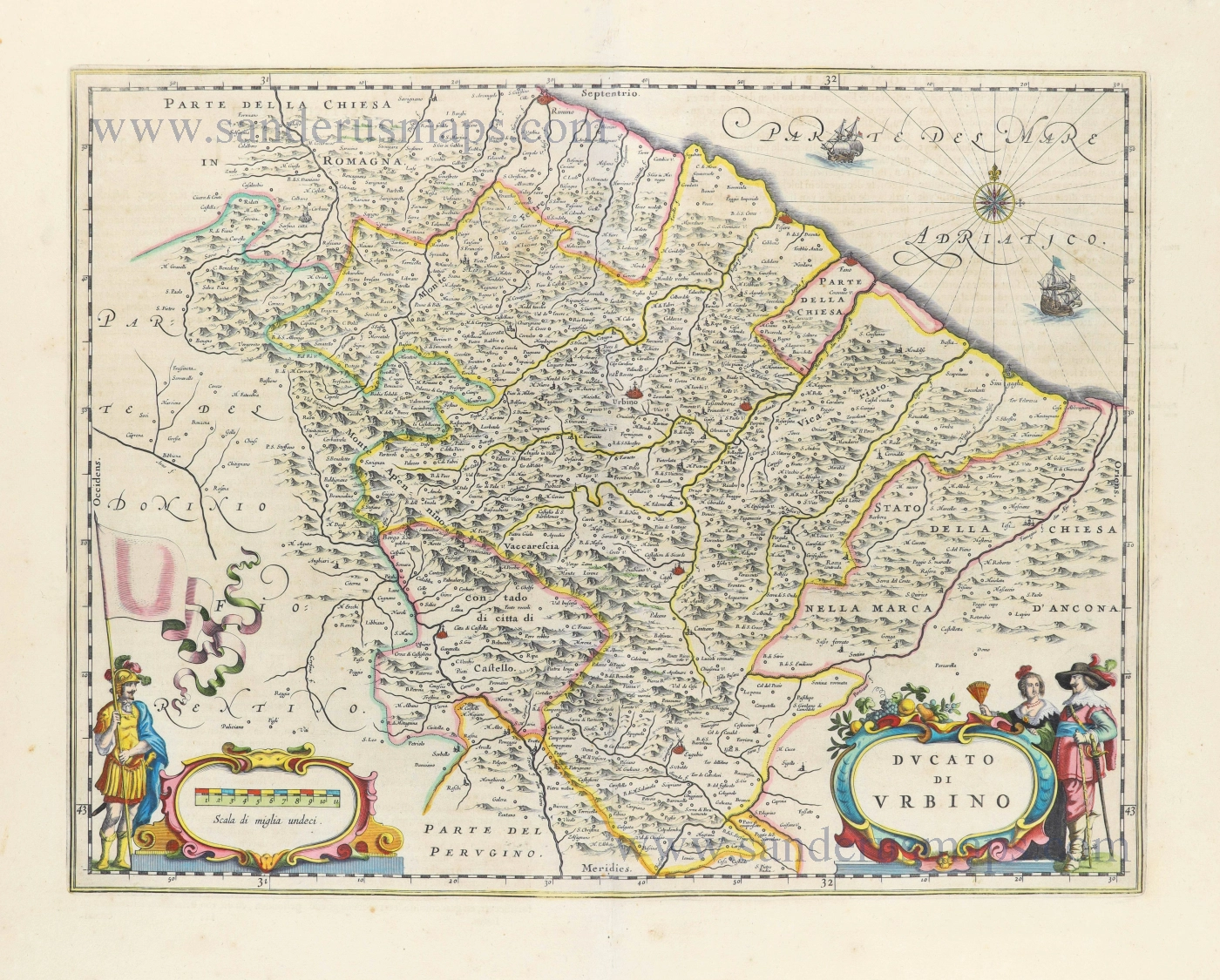Urbino and Sulmo by Georg Braun & Frans Hogenberg. 1617
URBINO
COMMENTARY BY BRAUN: "But afterwards, under Pope Sixtus IV, the city of Urbino was elevated from a county to the status of a duchy because of the magnificent gifts made to it by Federico and his admirable virtues. For he was a wise, eloquent and learned man: he loved witty men, was fortunate in war, in peace congenial, greatly esteemed by the Italian princes and loved and treasured by his own subjects. He adorned the city of Urbino with magnificent houses, chief among them the stately building in which he also had a vast library installed, which he provided with large numbers of the very best books that were, moreover, bound and decorated in gold, silver and silks."
This simplified representation of Urbino has been reduced to essentials and consists of two views. Seen from the southwest in the upper of the two pictures is the Palazzo Ducale built into the slope. Directly behind it appears the tower of the cathedral. In the foreground is the Porta Valbona, with the main axis of the city leading to the 14th-century church of San Francesco and, therefore, to the centre of the Old Town. Urbino is seen from the opposite direction, northeast, in the lower picture, with the Porta Lavigne in the foreground. Founded by the Romans, Urbino was a fief of the Counts of Montefeltro, who ruled Urbino from 1444 to 1482. A committed advocate of humanism, Frederico was an ardent patron of the arts and sciences and his court, at which he assembled Italy's leading artists and scholars, was one of the most brilliant of the era. Urbino is celebrated today as the birthplace of the painter Raphael, whose father participated in that flowering of cultural history by being in Frederico's employ.
SULMONA
CARTOUCHE: Sulmona, Ovid's birthplace.
COMMENTARY BY BRAUN: "Sulmo, a town of the Bruttii in the territory of the Paeligni, was originally called Solymum [...]. However, in the present day, it is called Sulmona, as Leander wrote, and is the birthplace of the venerated poet Ovidius Naso, as he attests in his verses: "My home is Sulmo, abounding in cool waters, nine times ten miles distant from Rome". [...] The city of Sulmona is celebrated especially for its beauty, the number of its inhabitants and its superabundance of water."
Surrounded by 14th-century fortifications, the city is seen in bird's-eye from the northwest. In the lower centre are the church and palace of Santissima Annunziata, above which is San Francesco della Scarpa with the Portale di San Francesco. Immediately above this is the church of Santa Maria Della Tomba, which was built on the site of the temple to Jupiter. The inscription to the left refers to this temple and, like the cartouche, discloses why this particular city was included in the present work: as the birthplace of the Roman poet Ovid (b. 43 BC), Sulmona was a name all Renaissance humanists revered. (Taschen)
Braun G. & Hogenberg F. and the Civitates Orbis Terrarum.
The Civitates Orbis Terrarum, also known as the 'Braun & Hogenberg', is a six-volume town atlas and the most excellent book of town views and plans ever published: 363 engravings, sometimes beautifully coloured. It was one of the best-selling works in the last quarter of the 16th century. Georg Braun, a skilled writer, wrote the text accompanying the plans and views on the verso. Many plates were engraved after the original drawings of a professional artist, Joris Hoefnagel (1542-1600). The first volume was published in Latin in 1572 and the sixth in 1617. Frans Hogenberg, a talented engraver, created the tables for volumes I through IV, and Simon van den Neuwel made those for volumes V and VI. Other contributors were cartographers Daniel Freese and Heinrich Rantzau, who provided valuable geographical information. Works by Jacob van Deventer, Sebastian Münster, and Johannes Stumpf were also used as references. Translations appeared in German and French, making the atlas accessible to a broader audience.
Since its original publication of volume 1 in 1572, the Civitates Orbis Terrarum has left an indelible mark on the history of cartography. Seven more editions followed the first volume in 1575, 1577, 1582, 1588, 1593, 1599, and 1612. Vol.2, initially released in 1575, saw subsequent editions in 1597 and 1612. The subsequent volumes, each a treasure trove of historical insights, graced the world in 1581, 1588, 1593, 1599, and 1606. The German translation of the first volume, a testament to its widespread appeal, debuted in 1574, followed by the French edition in 1575.
Several printers were involved: Theodor Graminaeus, Heinrich von Aich, Gottfried von Kempen, Johannis Sinniger, Bertram Buchholtz, and Peter von Brachel, all of whom worked in Cologne.
Georg Braun (1541-1622)
Georg Braun, the author of the text accompanying the plans and views in the Civitates Orbis Terrarum, was born in Cologne in 1541. After his studies in Cologne, he entered the Jesuit Order as a novice, indicating his commitment to learning and intellectual pursuits. In 1561, he obtained his bachelor's degree; in 1562, he received his Magister Artium, further demonstrating his academic achievements. Although he left the Jesuit Order, he continued his studies in theology, gaining a licentiate in theology. His theological background likely influenced the content and tone of the text in the Civitates Orbis Terrarum, adding a unique perspective to the work.
Frans Hogenberg (1535-1590)
Frans Hogenberg was a Flemish and German painter, engraver, and mapmaker. He was born in Mechelen as the son of Nicolaas Hogenberg.
By the end of the 1560s, Frans Hogenberg was employed upon Abraham Ortelius's Theatrum Orbis Terrarum, published in 1570; he is named an engraver of numerous maps. In 1568, he was banned from Antwerp by the Duke of Alva and travelled to London, where he stayed a few years before emigrating to Cologne. He immediately embarked on his two most important works, the Civitates, published in 1572 and the Geschichtsblätter, which appeared in several series from 1569 until about 1587.
Thanks to large-scale projects like the Geschichtsblätter and the Civitates, Hogenberg's social circumstances improved with each passing year. He died as a wealthy man in Cologne in 1590.
Urbino - Sulmo Ovidii Patria.
Item Number: 16430 Authenticity Guarantee
Category: Antique maps > Europe > Italy - Cities
Two bird's-eye views by Georg Braun & Frans Hogenberg: Urbino and Sulmona..
Title: Urbino - Sulmo Ovidii Patria.
Date of the first edition: 1588.
Date of this map: 1617.
Copper engraving, printed on paper.
Size (not including margins): 330 x 465mm (12.99 x 18.31 inches).
Verso: Latin text.
Condition: Excellent, superb old colour.
Condition Rating: A+.
References: Van der Krogt 4, #4537; Taschen, Br. Hog., p. 331; Fauser, #14501 & #13645
From: Liber Quartus Urbium Praecipuarum Totius Mundi. Cologne, Petrus von Brachel, 1617. (Van der Krogt 4, 41:1.4(1617))
URBINO
COMMENTARY BY BRAUN: "But afterwards, under Pope Sixtus IV, the city of Urbino was elevated from a county to the status of a duchy because of the magnificent gifts made to it by Federico and his admirable virtues. For he was a wise, eloquent and learned man: he loved witty men, was fortunate in war, in peace congenial, greatly esteemed by the Italian princes and loved and treasured by his own subjects. He adorned the city of Urbino with magnificent houses, chief among them the stately building in which he also had a vast library installed, which he provided with large numbers of the very best books that were, moreover, bound and decorated in gold, silver and silks."
This simplified representation of Urbino has been reduced to essentials and consists of two views. Seen from the southwest in the upper of the two pictures is the Palazzo Ducale built into the slope. Directly behind it appears the tower of the cathedral. In the foreground is the Porta Valbona, with the main axis of the city leading to the 14th-century church of San Francesco and, therefore, to the centre of the Old Town. Urbino is seen from the opposite direction, northeast, in the lower picture, with the Porta Lavigne in the foreground. Founded by the Romans, Urbino was a fief of the Counts of Montefeltro, who ruled Urbino from 1444 to 1482. A committed advocate of humanism, Frederico was an ardent patron of the arts and sciences and his court, at which he assembled Italy's leading artists and scholars, was one of the most brilliant of the era. Urbino is celebrated today as the birthplace of the painter Raphael, whose father participated in that flowering of cultural history by being in Frederico's employ.
SULMONA
CARTOUCHE: Sulmona, Ovid's birthplace.
COMMENTARY BY BRAUN: "Sulmo, a town of the Bruttii in the territory of the Paeligni, was originally called Solymum [...]. However, in the present day, it is called Sulmona, as Leander wrote, and is the birthplace of the venerated poet Ovidius Naso, as he attests in his verses: "My home is Sulmo, abounding in cool waters, nine times ten miles distant from Rome". [...] The city of Sulmona is celebrated especially for its beauty, the number of its inhabitants and its superabundance of water."
Surrounded by 14th-century fortifications, the city is seen in bird's-eye from the northwest. In the lower centre are the church and palace of Santissima Annunziata, above which is San Francesco della Scarpa with the Portale di San Francesco. Immediately above this is the church of Santa Maria Della Tomba, which was built on the site of the temple to Jupiter. The inscription to the left refers to this temple and, like the cartouche, discloses why this particular city was included in the present work: as the birthplace of the Roman poet Ovid (b. 43 BC), Sulmona was a name all Renaissance humanists revered. (Taschen)
Braun G. & Hogenberg F. and the Civitates Orbis Terrarum.
The Civitates Orbis Terrarum, also known as the 'Braun & Hogenberg', is a six-volume town atlas and the most excellent book of town views and plans ever published: 363 engravings, sometimes beautifully coloured. It was one of the best-selling works in the last quarter of the 16th century. Georg Braun, a skilled writer, wrote the text accompanying the plans and views on the verso. Many plates were engraved after the original drawings of a professional artist, Joris Hoefnagel (1542-1600). The first volume was published in Latin in 1572 and the sixth in 1617. Frans Hogenberg, a talented engraver, created the tables for volumes I through IV, and Simon van den Neuwel made those for volumes V and VI. Other contributors were cartographers Daniel Freese and Heinrich Rantzau, who provided valuable geographical information. Works by Jacob van Deventer, Sebastian Münster, and Johannes Stumpf were also used as references. Translations appeared in German and French, making the atlas accessible to a broader audience.
Since its original publication of volume 1 in 1572, the Civitates Orbis Terrarum has left an indelible mark on the history of cartography. Seven more editions followed the first volume in 1575, 1577, 1582, 1588, 1593, 1599, and 1612. Vol.2, initially released in 1575, saw subsequent editions in 1597 and 1612. The subsequent volumes, each a treasure trove of historical insights, graced the world in 1581, 1588, 1593, 1599, and 1606. The German translation of the first volume, a testament to its widespread appeal, debuted in 1574, followed by the French edition in 1575.
Several printers were involved: Theodor Graminaeus, Heinrich von Aich, Gottfried von Kempen, Johannis Sinniger, Bertram Buchholtz, and Peter von Brachel, all of whom worked in Cologne.
Georg Braun (1541-1622)
Georg Braun, the author of the text accompanying the plans and views in the Civitates Orbis Terrarum, was born in Cologne in 1541. After his studies in Cologne, he entered the Jesuit Order as a novice, indicating his commitment to learning and intellectual pursuits. In 1561, he obtained his bachelor's degree; in 1562, he received his Magister Artium, further demonstrating his academic achievements. Although he left the Jesuit Order, he continued his studies in theology, gaining a licentiate in theology. His theological background likely influenced the content and tone of the text in the Civitates Orbis Terrarum, adding a unique perspective to the work.
Frans Hogenberg (1535-1590)
Frans Hogenberg was a Flemish and German painter, engraver, and mapmaker. He was born in Mechelen as the son of Nicolaas Hogenberg.
By the end of the 1560s, Frans Hogenberg was employed upon Abraham Ortelius's Theatrum Orbis Terrarum, published in 1570; he is named an engraver of numerous maps. In 1568, he was banned from Antwerp by the Duke of Alva and travelled to London, where he stayed a few years before emigrating to Cologne. He immediately embarked on his two most important works, the Civitates, published in 1572 and the Geschichtsblätter, which appeared in several series from 1569 until about 1587.
Thanks to large-scale projects like the Geschichtsblätter and the Civitates, Hogenberg's social circumstances improved with each passing year. He died as a wealthy man in Cologne in 1590.

